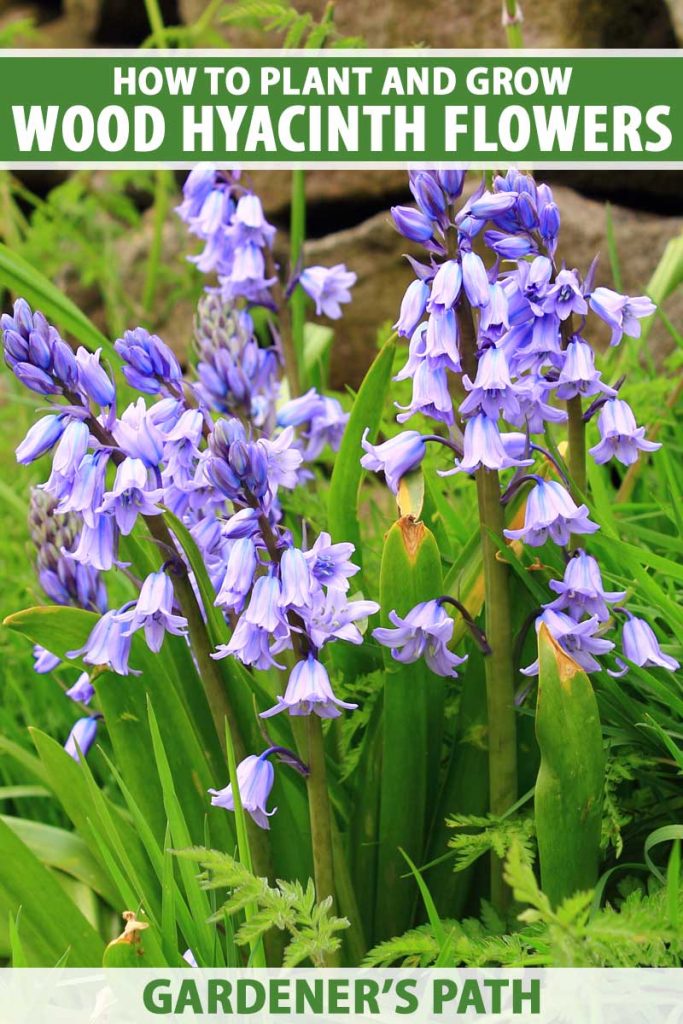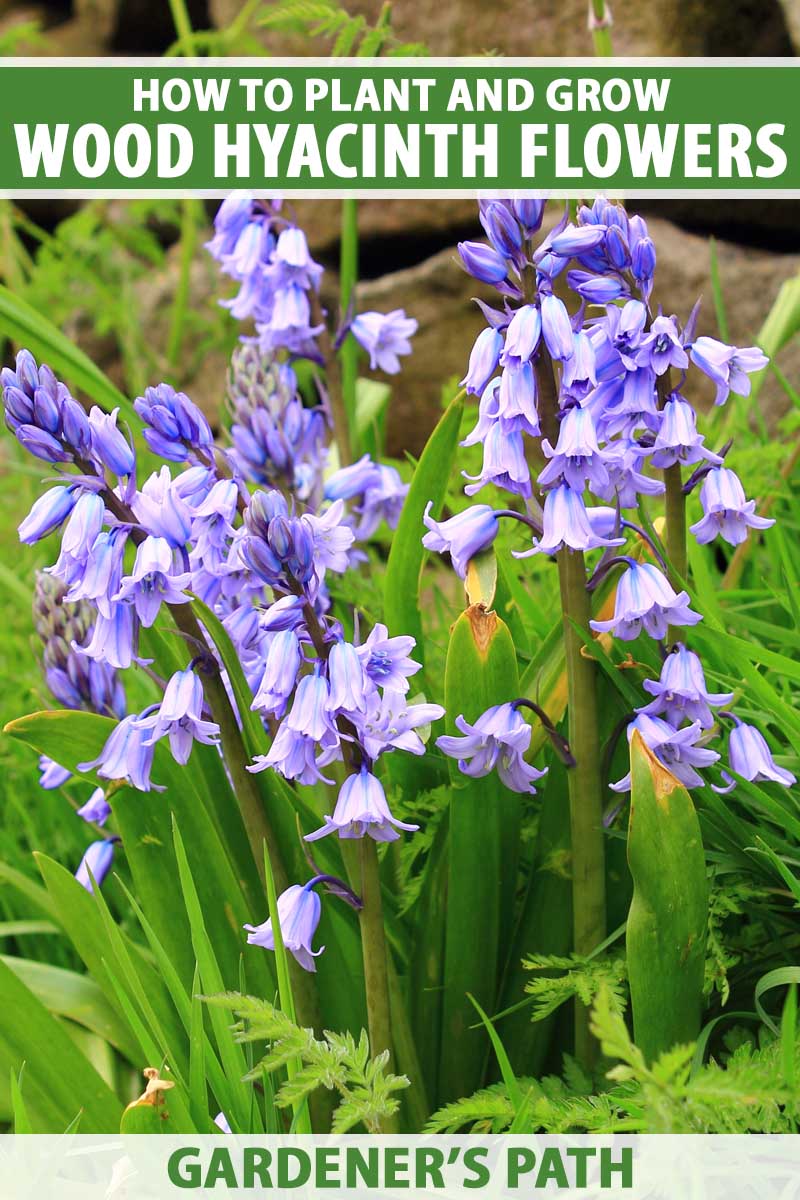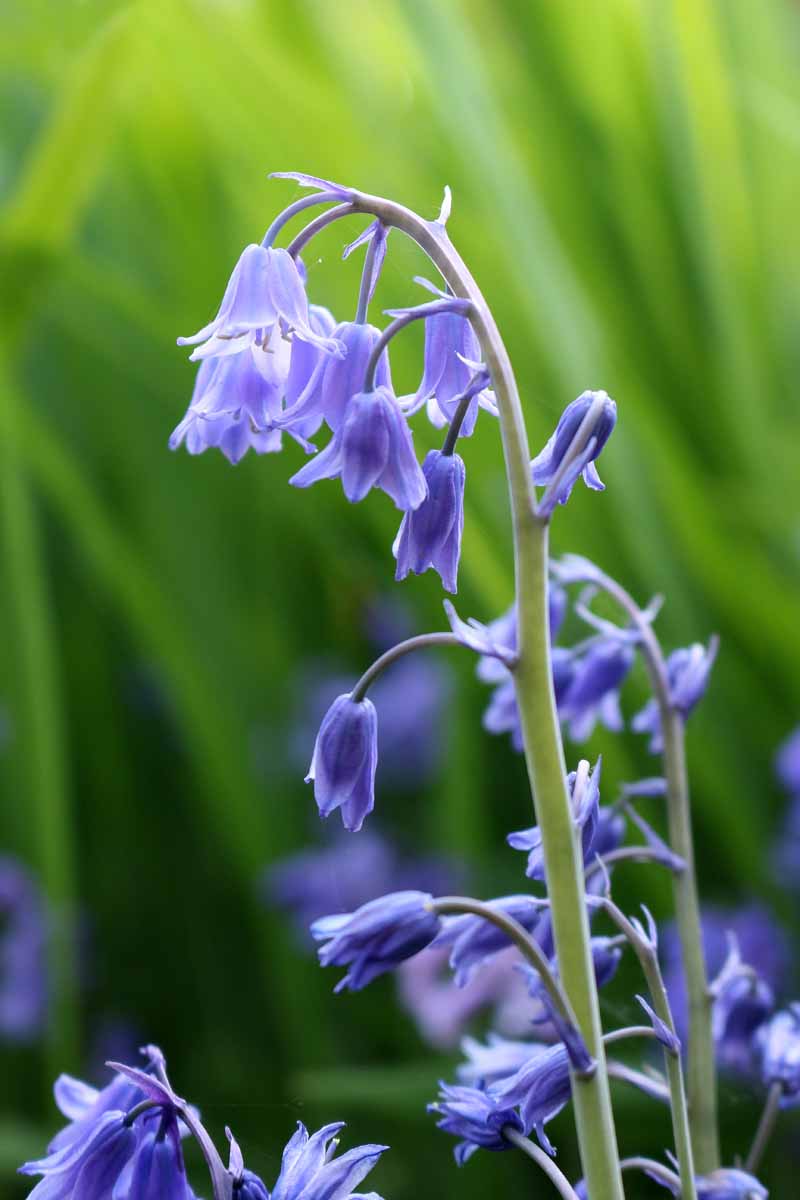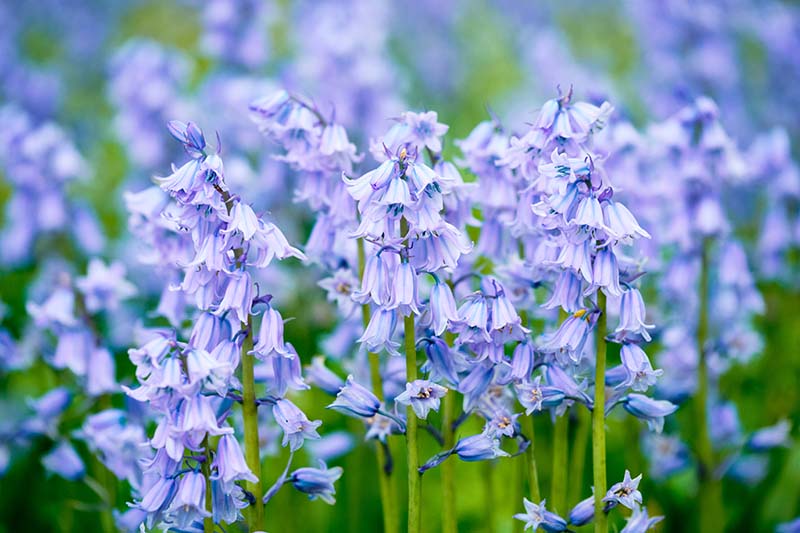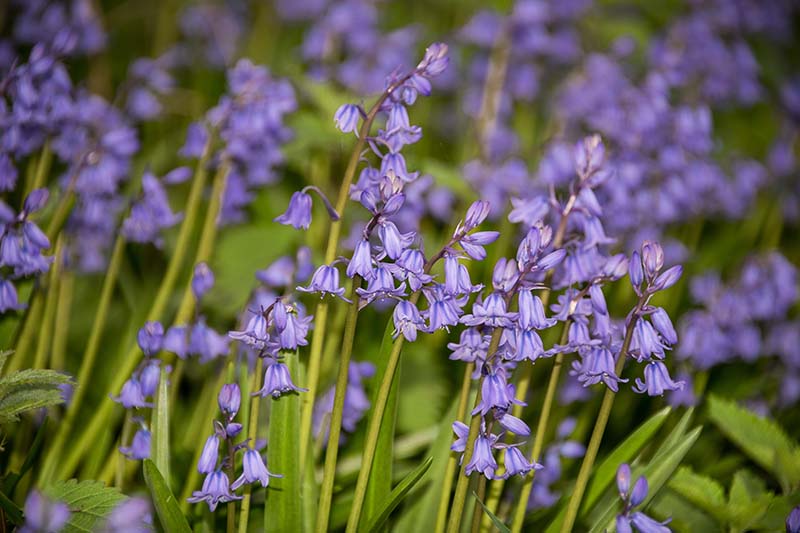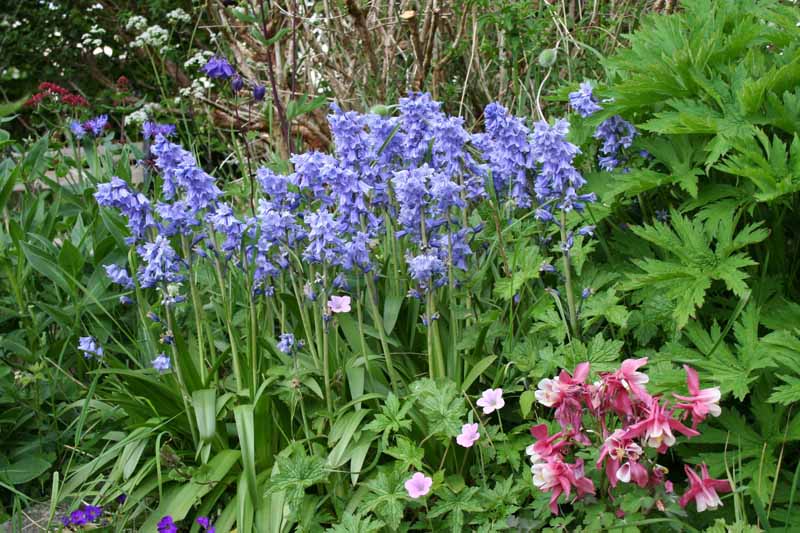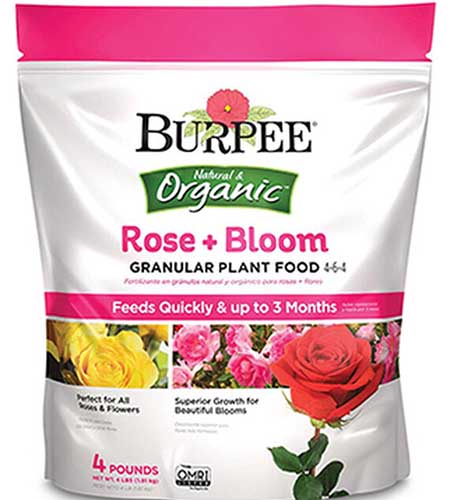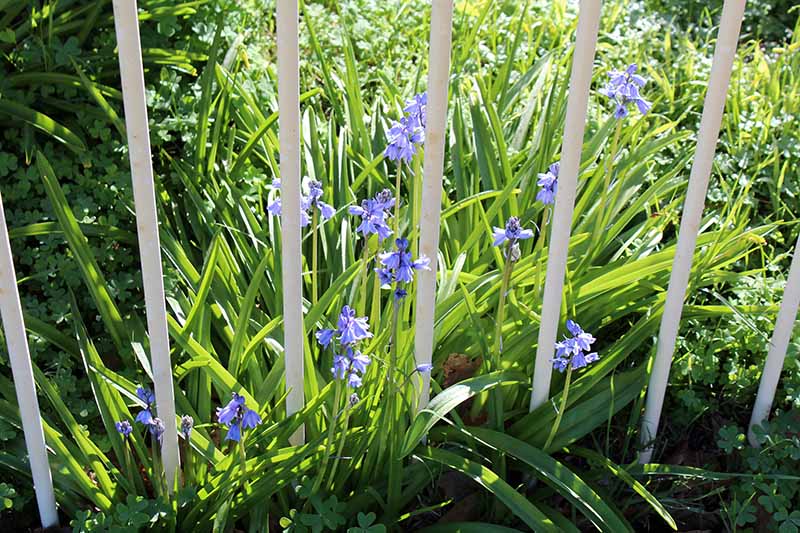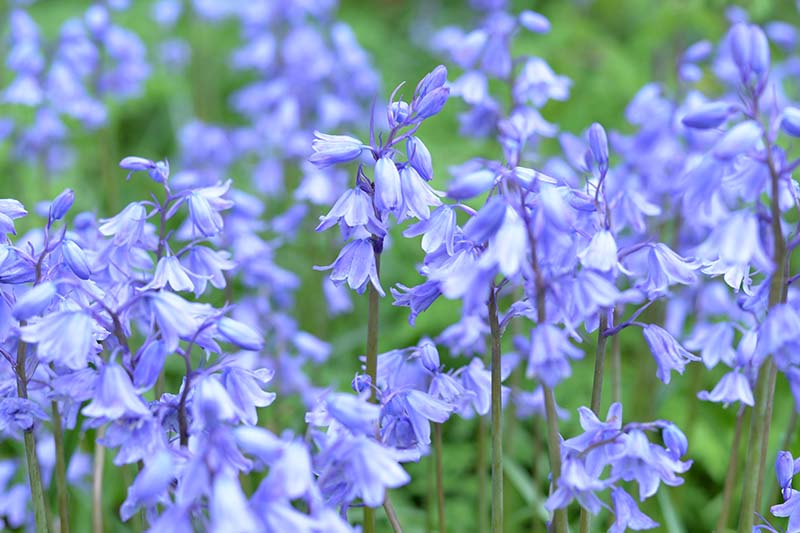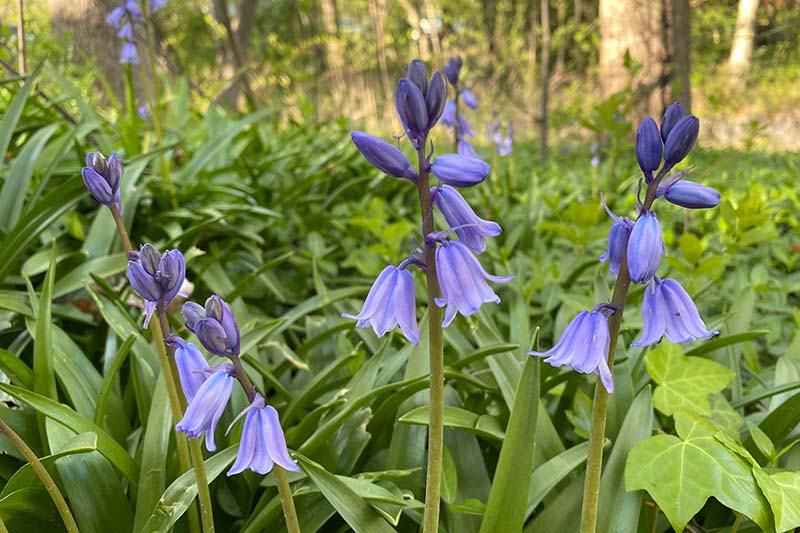These versatile spring bloomers provide a riot of blue-lavender, pink, or white bell-shaped flowers from April to May. Low maintenance and robust, wood hyacinths were regarded as a staple in many old English gardens, and the blooms are still loved today. We link to vendors to help you find relevant products. If you buy from one of our links, we may earn a commission. Here’s the lineup:
Cultivation and History
Hyacinthoides hispanica, also known as Spanish bluebell, wood hyacinth, large bluebell, or squill, is native to Spain, Portugal, and northwest Africa. The pretty bell-shaped flowers, often a deep blue-periwinkle shade, make the reasoning behind the common name “bluebell” obvious. “Hyacinth,” translated from the genus name Hyacinthoides, is derived from the Greek hyákinthos, which was the name of a legendary youth accidentally killed by the god Zephyr. A flowering plant supposedly grew from his blood and was given his name. Spanish bluebell’s most common colloquial name, “wood hyacinth,” is likely derived from its love of the cool, dappled shade that woodlands and deciduous trees provide. “Squill” is normally a term for plants in the Asparagaceae subfamily, Scilloideae. In some places the botanical name is still listed as Scilla campanulata, S. hispanica, or more rarely, Endymion hispanicus. These wood hyacinths are distinct from other bluebells, such as the English or common bluebell, H. non-scripta. H. hispanica blooms later, are taller, and their flower bells sprout from all sides of the stem. The flowers have blue anthers and aren’t particularly fragrant, while English bluebells have creamy white anthers and are fragrant. Although they aren’t fragrant, the flowers attract a variety of pollinators, including bees and butterflies. Thanks to efficient visiting pollinators, English and Spanish bluebells will hybridize if planted near each other. The result: a plant called H. x massartiana. You never know what you’ll get with this hybrid. It’s variable in looks, has a combination of traits from both parents, and is common in the UK. True Spanish bluebells are rare, and the hybrid is often misidentified as Spanish bluebell. Wood hyacinths will spread readily and are considered invasive in the Pacific Northwest. Consider carefully before planting and check local regulations first in areas where they are banned or may become a problem. These plants are poisonous, thanks to the presence of cardiac glycosides. They are highly toxic if eaten.
Propagation
Wood hyacinth can be propagated by seed or from bulb offsets.
From Seed
Once ripe, the seeds are transported to different areas of the garden by ants, so sometimes flowers will appear in strange places. You can collect the seeds from your own flowers if H. non-scripta is not planted nearby, or if you don’t mind propagating a hybrid. Alternatively, purchase open-pollinated seeds to guarantee you are planting pure H. hispanica. Sow the seeds as soon as you collect them in the summer. Place individually in small three- or four-inch pots filled with a well draining potting soil, cover with a thin layer of compost or soil, and keep the medium moist. The seeds don’t appreciate artificial heat, and prefer a cool, shaded area outdoors to germinate. Be patient. These seeds are in no hurry, and most will not germinate until the following spring. To protect the pots during the winter, place in a cold frame, against a wall or tree. Once germinated, grow individual seedlings in their pots until their roots are established and each plant is strong enough to be transplanted into a bigger pot or into the ground. Plants grown from seed may take several years to flower as they put all their energy into developing a strong bulb.
From Bulb Offsets
Dividing bulb offsets is a good way to guarantee true Spanish bluebells – as they are clones of the parent – and they will flower quicker than those grown from seed. Once established, these plants quickly develop aboveground clumps which indicate the presence of healthy bulb offsets below ground. Remove bulb offsets in mid to late summer as soon as the leaves have died. Carefully dig up the bulb and remove offsets with your hands. Read more about how to propagate bulbs at home in our guide. Replant immediately to avoid allowing the roots to dry out. Prepare the soil by loosening and amending with compost. Plant the offsets root side down, three to four inches deep, and four to six inches apart. Water in well.
Bulbs and Transplants
Purchased bulbs and plants can be planted in the garden in the fall. As with bulb offsets, prepare the soil by loosening and amending it with compost. Plant bulbs as you would offsets, as described above. Living plants can be transplanted in a hole dug to the same depth as the container. Backfill with soil, and water in well.
How to Grow
Wood hyacinths like cool areas and dappled shade. Sunnier spots can equal more blooms, but the color will be faded. Plants go dormant in early summer. These plants prefer organically rich, well draining, moist soil. They will tolerate a wide variety of soil types except for clay, preferring sandy and sandy-loam soils. Amend clay soils with compost and grit such as builder’s sand to improve drainage and loosen the texture before planting. They tolerate a wide pH range as well, from 5.5 to 8.0, but do best in slightly acidic to neutral soils. Keep these plants well watered to support their rapid growth rate, but do not oversaturate the soil. Water when the soil is dry to a depth of two inches. Grow in containers as you would in the ground, in pots with adequate drainage holes, filled with well-draining potting soil. Take care to check soil moisture more often as containers tend to dry out more quickly than garden soil. Rose and Bloom Granular Plant Food What about growing wood hyacinths indoors? Why not! You can also force these bulbs to bloom for you during the winter. Start approximately 12 weeks before you want them to bloom. Add two inches of clean pebbles or glass beads to a wide-mouthed vase. Situate three to five bulbs (pointy side up) into the pebbles, adding a handful more to keep them upright. Add water up to just below the bottom of the bulbs, making sure the water isn’t touching them. Store in a dark place at 45 to 55°F and leave them there for eight weeks. Check the water level often and top up when necessary. After eight weeks, move the vase to a warmer, well-lit room but keep them out of direct sunlight for a week. Then move them to a location with direct sunlight and they should start blooming indoors after about two more weeks.
Growing Tips
Plant in areas with dappled shade.Keep the soil moist but not wet.Fertilize with a low nitrogen fertilizer in the spring.
Pruning and Maintenance
Remove spent flowers to avoid self seeding of potential undesirable hybrids. After flowering, the foliage will slowly wither. Although the fading foliage looks unattractive, do not remove it. The leaves are needed to harvest the sun’s energy for the following year’s blooms. Plant with ferns or hostas to mask the dying foliage. Wood hyacinth will spread via bulb offsets and seeds. To keep them from becoming a nuisance, overtaking susceptible plants, or sprouting in undesirable areas of the garden, there are a few things you can do. In addition to deadheading to prevent self-seeding, be sure to dig up offsets that have grown and multiplied while plants are still leafed out – these can be very difficult to locate while dormant. Do not throw unwanted plant parts onto the compost pile where they can grow. Instead, dispose of them in the trash. Planting in containers instead of in the ground can also help to prevent unwanted spread.
Cultivars to Select
The most popular color is of course the classic blue, but wood hyacinth comes in pink and white versions as well. Keep an eye out for these cultivars, which may be available at your local nursery or garden center: Wood Hyacinth Bulbs Packages of 100 bulbs are available from Home Depot.
Dainty Maid
‘Dainty Maid’ combines the best of the blue and pink varieties and is truly a stunner, with its violet-pink flower bells contrasted against bright green stems and foliage.
Excelsior
‘Excelsior’ is a very popular cultivar. It is taller than most, and features glossy green leaves and the deep blue-violet flower bells that gave bluebells their name.
Miss World
The pink to pink-violet bells of this pretty cultivar really lighten up shady areas with a flush of spring color.
White City
With bright white flowers, this fresh beauty adds stark contrast to a woodland garden.
Managing Pests and Disease
You’re in luck. Not only are wood hyacinths resistant to deer, rabbits, and rodents, they are generally unaffected by serious insect pests and diseases as well, given the conditions they prefer. Slugs and snails can become an issue, especially during wet spring weather. They’re plant chewing machines, and love snacking on leaves, flowers, and any other soft plant parts. Read all about how to protect your garden from slugs and snails. Be sure to choose a well-draining area of the garden to prevent potential problems with rot, or plant in containers with plenty of drainage holes, in a porous medium. Avoid oversaturating the soil. Planting and forgetting them is possible with these spring bulbs! That is, until these stunners start blooming…
Best Uses
Imagine drifts of blue under a canopy of fresh-leaved deciduous trees, bursting into blossom in the dappled sunlight. Plant your wood hyacinths in woodland gardens, in borders, and in rock gardens. Mix them with other colorful bulb plantings such as tulips and daffodils to herald spring. These plants do well in wild and naturalized plantings, in containers on their own, or with other spring bulbs and flowers. “O, that lone flower recalled to me, My happy childhood’s hours When bluebells seemed like fairy gifts A prize among the flowers…” Showy, robust, and most commonly seen in that iconic eye-pleasing shade of violet-blue, Spanish bluebells hold their own in the spring landscape. They’re tall enough to add some height and layers to bulb plantings, but still short enough to be the perfect spring planter bulb. Bluebells are old garden favorites, well-loved and sometimes linked with some fond memories. We want to hear about your experiences, whether you cultivate them yourself or remember them fondly. Tell us about it in the comments below! And for more information about growing flowering bulbs in your garden, have a read of these articles next:
How to Grow Heavenly Hyacinths for Rich Spring Color and Sweet PerfumeHow to Grow and Care for Crocus FlowersDelightful Dahlias: A Late Summer Standard
